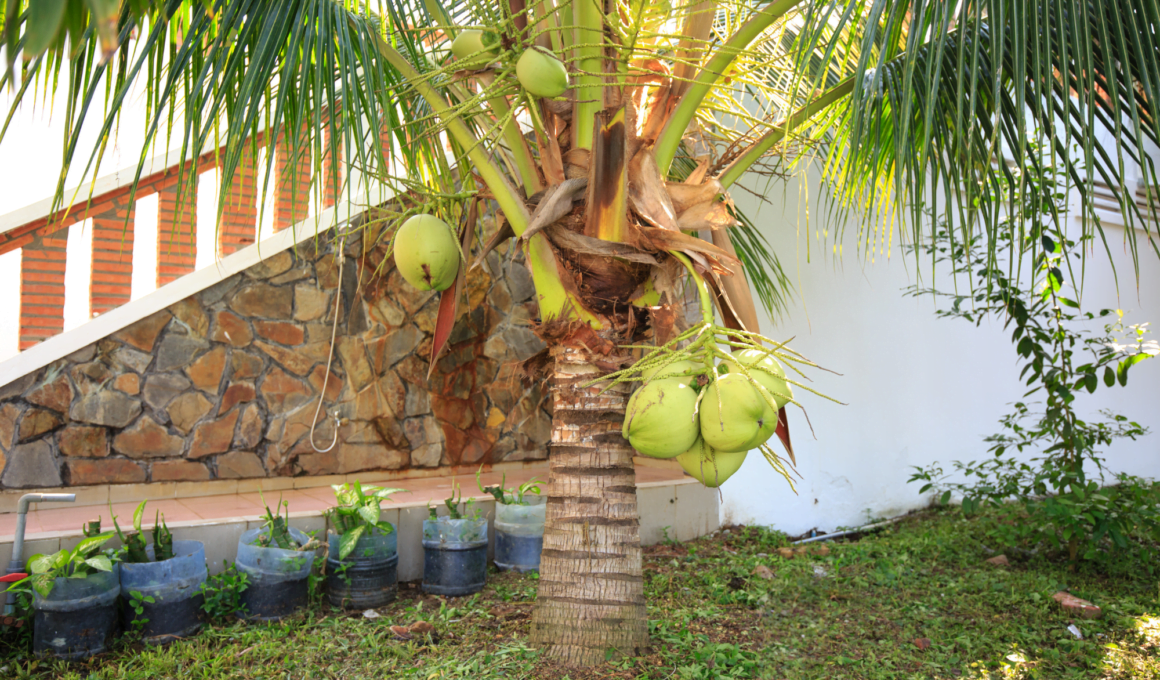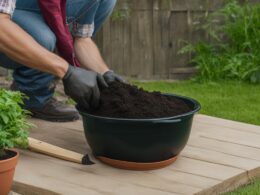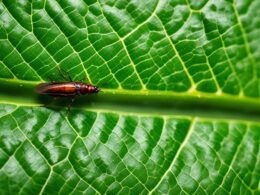Welcome to our comprehensive guide on growing dwarf fruit trees in your garden. If you have limited space or want to create an edible landscape, dwarf fruit trees are an excellent option. In this section, we will explore the different types of dwarf fruit trees that you can consider for your garden. From popular varieties to the best options for small spaces, we’ve got you covered.
Before we dive into specific varieties, let’s briefly touch on what dwarf fruit trees are. Essentially, these are smaller versions of regular fruit trees, created by grafting fruiting branches onto dwarfing rootstocks. The result is a tree that takes up less space, is easier to manage, and still produces delicious fruit.
Understanding Dwarf Fruit Trees
If you have limited space in your garden but still want to enjoy the benefits of growing fruit trees, dwarf fruit trees might be the perfect solution for you. Dwarf fruit trees are small in size but still provide an abundance of fruit.
Understanding the characteristics of dwarf fruit trees can help you select the right varieties for your garden. Dwarf fruit trees are created by grafting fruit tree varieties onto a rootstock that limits their growth. This process results in small fruit trees that are ideal for small gardens or containers. Unlike full-sized fruit trees that can reach up to 20 feet tall, dwarf fruit trees typically grow to a maximum of 6-10 feet tall.
One of the benefits of dwarf fruit trees is that they are easier to manage than full-sized fruit trees. They require less pruning, can be grown in containers, and are easier to harvest.
Additionally, dwarf fruit trees can be planted closer together than full-sized fruit trees, maximizing the use of limited garden space. Dwarf fruit trees are available in a variety of fruit types, including apples, peaches, pears, citrus, and cherries. Some popular dwarf fruit tree varieties include ‘Starkrimson’ red delicious apple, ‘Bonanza’ peach, ‘Bartlett’ pear, ‘Improved Meyer’ lemon, and ‘Stella’ cherry.
When selecting dwarf fruit trees for your garden, it’s important to consider their growing requirements, such as soil type, sun exposure, and watering needs. Additionally, some dwarf fruit trees require cross-pollination with other compatible varieties in order to produce fruit, so be sure to research the specific variety before planting.
Benefits of Dwarf Fruit Trees
Aside from their small size, dwarf fruit trees offer several benefits that make them a popular choice for small gardens or container gardening. One of the main advantages is their early fruit production.
Dwarf fruit trees typically begin bearing fruit within 2-3 years of planting, compared to full-sized fruit trees that can take 5-7 years to produce fruit. Dwarf fruit trees also provide an opportunity to grow a wider variety of fruit in a smaller space.
By planting different types of dwarf fruit trees, you can create a mini orchard or fruit tree border in your garden. This not only adds beauty and functionality to your outdoor space, but also provides fresh and healthy fruit for your family to enjoy.
Popular Dwarf Fruit Tree Varieties

| Fruit Tree | Description |
|---|---|
| Apple | There are many varieties of dwarf apple trees that are suited to small spaces. They produce crisp, juicy apples and are available in both sweet and tart flavors. Dwarf apple trees typically reach a height of 6-8 feet and require cross-pollination for fruit production. |
| Peach | Dwarf peach trees produce sweet, juicy fruit and are perfect for small gardens or container growing. They reach a height of 6-8 feet and require full sun and well-draining soil for best results. |
| Citrus | Dwarf citrus trees are ideal for growing in containers on patios or balconies. They produce a range of fruits, including oranges, lemons, limes, and grapefruits. Dwarf citrus trees need full sun and regular watering to thrive. |
| Cherry | Dwarf cherry trees are suitable for small gardens and container growing. They produce sweet, juicy fruit and are available in both sour and sweet varieties. Dwarf cherry trees require cross-pollination for fruit production and do best in full sun. |
Other popular types of dwarf fruit trees include apricot, fig, nectarine, and plum. When selecting a fruit tree, consider factors such as climate, available space, and pollination requirements. With the right care, dwarf fruit trees can produce bountiful harvests in even the smallest of gardens.
Best Dwarf Fruit Tree Options for Small Spaces

| Type of Fruit | Variety | Description |
|---|---|---|
| Apple | Bushel and Peck | This self-pollinating apple tree produces full-sized fruit on a miniature tree. It reaches a height of 4-6 feet and is suitable for containers or small gardens. |
| Peach | Elberta | This dwarf peach tree reaches a height of 8-10 feet and produces juicy, full-sized fruit. It is self-pollinating and ideal for small gardens or containers. |
| Citrus | Meyer Lemon | This popular citrus tree produces sweet and tangy fruit and can be grown in containers indoors or outdoors. It reaches a height of 4-6 feet and is suitable for small gardens or balconies. |
| Cherry | Stella | This self-pollinating cherry tree produces sweet and juicy fruit on a compact tree that reaches a height of 6-8 feet. It is ideal for small gardens or containers. |
In addition to these popular options, other dwarf fruit trees to consider include:
- Bonanza Dwarf Peach
- Nectarine Tree
- Dwarf Apricot Tree
- Dwarf Pear Tree
- Dwarf Plum Tree
When selecting the right dwarf fruit tree for your garden, consider factors such as your climate, available space, and pollination requirements. Choose a tree that is suitable for your specific needs and preferences.
Care Tips for Dwarf Fruit Trees
Proper care is critical to ensure healthy growth and abundant fruit production for dwarf fruit trees. Here are some essential tips to keep in mind:
Planting
Choose a sunny location with well-draining soil. Dig a hole that is twice as wide as the root ball and deep enough to cover the root system. Water the tree immediately after planting and regularly thereafter until it becomes established.
Watering
Dwarf fruit trees need regular watering, especially during dry spells. Water deeply once or twice a week, depending on weather conditions. Avoid overwatering, which can lead to root rot and other issues.
Pruning
Regular pruning is essential for maintaining the shape and health of dwarf fruit trees. Remove dead, diseased, or damaged wood, as well as any branches that cross or rub against each other. Prune in late winter or early spring before new growth appears.
Fertilizing
Feed your dwarf fruit trees with a balanced fertilizer formulated for fruit trees. Apply in early spring and again in late summer or early fall. Do not over-fertilize, as this can lead to excessive foliage growth and reduced fruit production.
Pest and Disease Control
Keep an eye out for common pests and diseases that can affect dwarf fruit trees, such as aphids, caterpillars, and fungal infections. Use organic pest controls whenever possible, and follow instructions carefully.
Are Dwarf Fruit Trees Suitable for Growing in California’s Climate?
Dwarf fruit trees are a suitable choice for growing in California’s climate, thanks to their adaptability. With a wide range of fruit varieties available, they can thrive in both northern and southern regions. From citrus trees like lemon and orange to apple and peach trees, these compact beauties can transform any backyard into a fruitful oasis. So, whether you reside in the sunny south or the cooler north, consider adding dwarf fruit trees to your garden to enjoy the bountiful harvests they offer, regardless of the types of grass in california.
Creating an Edible Landscape with Dwarf Fruit Trees
Dwarf fruit trees not only provide delicious fruit but also offer a unique opportunity to create an edible landscape in small spaces. With their compact size and attractive appearance, these trees can be incorporated into your garden design in a variety of ways.
One idea is to create a mini orchard, grouping several dwarf fruit trees together to form a productive and visually appealing area. This can be done in containers or directly in the ground, depending on your available space and preferences.
Another option is to use dwarf fruit trees as a border along a pathway or fence. This creates both a functional and decorative element, allowing you to incorporate edible plants into your overall garden design.
When selecting dwarf fruit trees for your edible landscape, consider the space available, soil conditions, and climate in your area. It’s also important to choose varieties that are suitable for your intended use – whether for fresh eating, baking, or canning.
With proper care and maintenance, your dwarf fruit trees will not only provide tasty fruit but also add beauty and functionality to your outdoor space. Consider incorporating these small trees into your garden design and enjoy the benefits of a mini orchard right in your own backyard.
Selecting the Right Dwarf Fruit Tree for Your Garden
Choosing the perfect dwarf fruit tree for your garden can be challenging, especially with so many options available in the market. You need to consider several factors, including climate, available space, and pollination requirements, to make a wise decision. In this section, we will provide guidance on how to select the right dwarf fruit tree for your specific needs.
Consider Your Climate
The climate in your area plays a crucial role in determining which dwarf fruit trees are suitable for your garden. Some fruit trees require specific temperature and weather conditions to grow, while others can thrive in different climates. Before making a purchase, research the ideal climate for the fruit tree you are interested in, and ensure that it is compatible with your region’s climate.
Assess Your Available Space
Dwarf fruit trees are ideal for small gardens or container gardening, but they still require a certain amount of space to grow. Before selecting a fruit tree, assess your available space and ensure that it can provide the tree with adequate room to grow. Consider the height and spread of the tree and ensure that it can fit comfortably in your garden without causing overcrowding or obstructing other plants.
Pollination Requirements
Some dwarf fruit trees require cross-pollination to produce fruit, while others are self-pollinating. If you opt for a fruit tree that requires cross-pollination, you will need to purchase two trees of the same type, one for pollination and the other for fruit production. Ensure that you have enough space and budget to accommodate two fruit trees, and research the best type of pollinator tree that is compatible with your chosen fruit tree.
FAQ about Dwarf Fruit Trees
As with any gardening pursuit, growing dwarf fruit trees may come with its own set of questions and concerns. Here are some of the most frequently asked questions about dwarf fruit trees:
What is the difference between a dwarf fruit tree and a standard fruit tree?
Dwarf fruit trees are smaller in size and have been specifically bred to have a smaller root system and shorter stature. They are ideal for smaller gardens or container gardening. Standard fruit trees, on the other hand, can grow up to 30 feet tall and require a significant amount of space.
Do dwarf fruit trees produce fruit?
Yes! Dwarf fruit trees can produce just as much fruit as standard fruit trees, but in a smaller size. They can be more productive than standard trees because their fruit is often easier to reach and harvest.
Do I need to pollinate my dwarf fruit tree?
It depends on the variety. Some dwarf fruit trees are self-pollinating, while others require a separate pollinator tree nearby. It’s important to check the pollination requirements of the specific variety you choose and ensure you have the necessary pollinator trees if needed.
Can I grow dwarf fruit trees in containers?
Yes! Dwarf fruit trees are ideal for container gardening, as their smaller size and root system make them well-suited for growing in pots. Just make sure to choose a container that is large enough for the tree’s root system and follow proper care guidelines for container-grown plants.
How often should I fertilize my dwarf fruit tree?
Dwarf fruit trees should be fertilized once a year, in the spring, before new growth begins. Use a balanced fertilizer that is specifically formulated for fruit trees, and follow the package instructions for application rates.
When should I prune my dwarf fruit tree?
Dwarf fruit trees should be pruned during their dormant season, typically in late winter or early spring before new growth begins. Pruning helps to shape the tree and promote fruit production. Consult a pruning guide or gardening expert for specific instructions on how to prune your specific variety of dwarf fruit tree.









